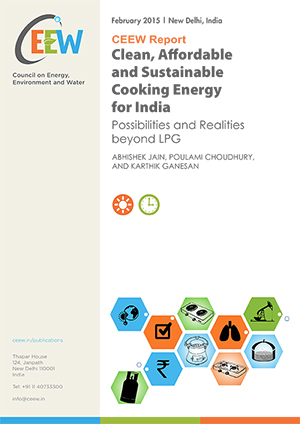Report
Clean, Affordable and Sustainable Cooking Energy for India
Possibilities and Realities Beyond LPG
Abhishek Jain, Poulami Choudhury, Karthik Ganesan
February 2015 |
Suggested Citation: Jain, Abhishek , Poulami Choudhury, and Karthik Ganesan. 2015. Clean, Affordable and Sustainable Cooking Energy for India: Possibilities and Realities Beyond LPG. New Delhi: Council on Energy, Environment and Water.
Overview
Over the last few years, the number of Liquefied Petroleum Gas (LPG) connections in the country have increased at an unprecedented rate. However, many households continue to use traditional fuels which contribute to indoor air pollution and drudgery.
With the objective of promoting clean, affordable and sustainable cooking energy for all, this study analyses the potential of the clean cooking energy alternatives going beyond LPG. This is a comparative analysis of various cooking energy options across a range of parameters including economics, fuel supply assurance, technology resilience, cooking convenience, environmental impacts, etc. to provide a holistic and comprehensive view of the state of technology options.
Key Findings
- In terms of economic viability, biogas and PNG emerged as the most attractive option while LPG and pellet-based cookstoves are among the costliest.
- Improved cookstoves need significant technological improvements to reduce emissions to safe levels.
- Traditional biomass has the highest fuel supply assurance, followed by PNG, biogas, LPG and electricity-based solutions.
- LPG and PNG, along with biogas, score high on parameters of cooking convenience due to their improved heat control, higher heat intensities, accommodation to variety of cooking needs etc. Improved cookstoves are deemed as least convenient among these.
- Electricity-based cooking is not considered a large-scale cooking energy alternative due to intermittent power supply, competing needs for electricity, reliance on thermal (coal-based) generation and economics.
- All clean cooking energy technologies are considered better than traditional chulhas, in terms of the global environmental impacts. This is due to avoidance of high emissions of black carbon resulting from incomplete combustion in traditional stoves.
Key Recommendations
- Devise a unified approach to provide clean, affordable and sustainable cooking energy to all, giving different technologies their fair share of attention (funds) and adequate direction of interventions.
- Create awareness about the negative impacts of the use of traditional chulhas, in order to generate a bottom-up demand of clean cooking solutions while ensuring their sustained use and a complete transition.
- Promote PNG in urban areas, beginning with densely populated cities, while developing long-term strategies for sourcing the commodity at competitive prices.
- Create an enabling environment to support market-based promotion of biogas as a cooking energy solution and eliminating the technology and management-related challenges through innovative approaches.
- Focus on technology development for improved cookstoves in order to improve emission performance, technology resilience, and cooking convenience.
Unless there is a complete transition to cleaner cooking option, at household-level and community level, the health benefits of clean cooking would not be realised completely.





